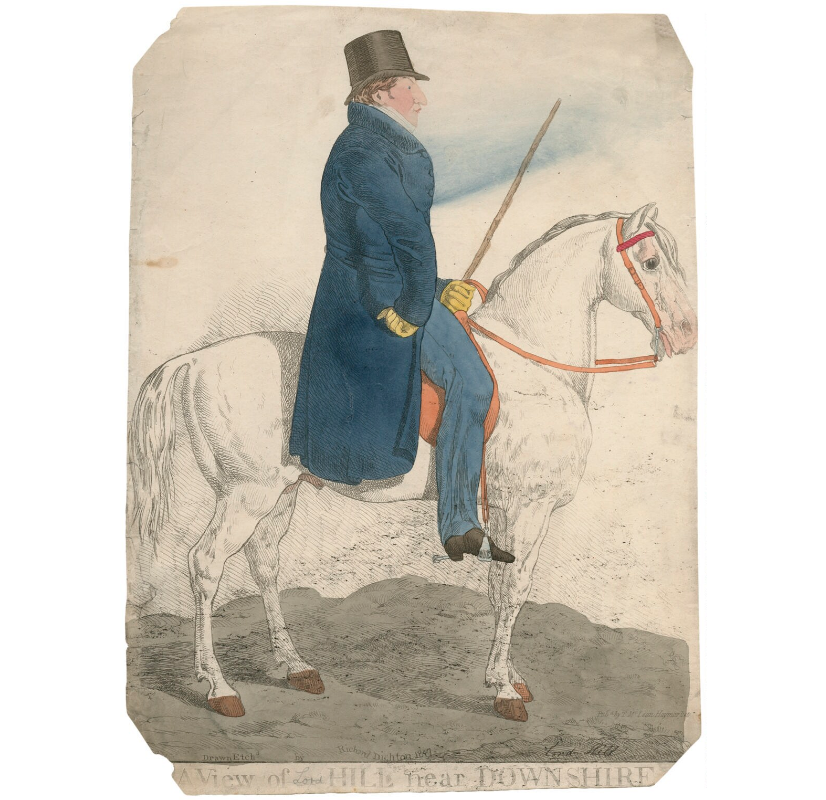Anne’s reading the “guest book” at Bolkesjø, Telemark (Norway) and finds that “the earl fo Hillsborough” had been there in 1833.
found that the “Earl of Hillsborough” was here 29 august 1833 apparently Lord Cantelup with him
Anne Lister, travel journal August 4. 1839, at Bolkesjø
The “Earls of Hillsborough” could either be Arthur Blundell Sandys Trumbull Hill, 3rd Marquess of Downshire KP (1788 – 1845) or his son Arthur Wills Blundell Sandys Trumbull Windsor Hill, 4th Marquess of Downshire KP (1812 – 1868)

Arthur Blundell Sandys Trumbull Hill, 3rd Marquess of Downshire KP (8 October 1788, Hanover Square – 12 September 1845) was an Anglo-Irish peer, styled Viscount Fairford from 1789 until 1793 and Earl of Hillsborough from 1793 to 1801. He was born in Hanover Square, the eldest son of Arthur Hill, 2nd Marquess of Downshire and his wife-Mary Sandys. He became Marquess of Downshire on the early death of his father in 1801. He was educated at Eton and Christ Church, Oxford. He gained his bio MA in 1809 and a DCL in 1810. In 1811 he married Lady Mary Windsor, daughter of Other Windsor, 5th Earl of Plymouth. They had five children: - Arthur Wills Blundell Sandys Trumbull Windsor Hill, 4th Marquess of Downshire (1812–1868) - Lady Charlotte Augusta Hill (30 June 1815 – 24 November 1861), married Sir George Chetwynd, 3rd Baronet - Captain Lord William Frederick Arthur Montagu Hill (10 July 1816 – 18 Mar 1844), Scots Greys, killed in a hunting accident - Lady Mary Penelope Hill (3 September 1817 – 15 July 1884), married Alexander Hood, 1st Viscount Bridport - Arthur Edwin Hill-Trevor, 1st Baron Trevor (1819–1894) During his early political career, Downshire was identified with the Whigs and supported the reform of Parliament. After the Grey Ministry came to power, he received a succession of appointments, becoming Colonel of the South Down Militia on 25 March 1831 and carrying the second sword at the coronation of William IV on 8 September. He was appointed a deputy lieutenant of Berkshire on 20 September, Lord Lieutenant of Down on 17 October (a new office replacing the Governor of Down), and finally a Knight of the Order of St Patrick on 24 November 1831. He received an LL.D from Cambridge on 6 July 1835. Hill was a very strong supporter of the Irish language, and was president of the Ulster Gaelic Society (est. 1830). In this capacity he played an important role in helping preserve records of the language, poetry, folk and song collections and much else. Arthur Wills Blundell Sandys Trumbull Windsor Hill, 4th Marquess of Downshire KP (6 August 1812 – 6 August 1868) was an Irish peer, styled Earl of Hillsborough until 1845. Marquess of Downshire in The Official Baronage of England, v. 2 (1886) The eldest son of Arthur Hill, 3rd Marquess of Downshire, Hillsborough was educated at Eton and Christ Church, Oxford. He was commissioned an ensign in the Royal South Down Militia, of which his father was colonel, on 4 June, and was commissioned lieutenant-colonel in the same on 10 September. He was appointed Sheriff of County Down for 1834. From 1836 until 1845, he represented Down in Parliament, and was a justice of the peace for the county as well. On 23 August 1837, he married Hon. Caroline Frances Stapleton Cotton, the eldest daughter of Stapleton Cotton, 1st Viscount Combermere. They had four children: - Arthur Hill, Viscount Kilwarlin (10 June 1841 – 28 June 1841) - Lady Alice Maria Hill (7 November 1842 – 25 February 1928), married Thomas Taylour, Earl of Bective - Arthur Hill, 5th Marquess of Downshire (1844–1874) - Col. Lord Arthur William Hill (1846–1931) He became Marquess of Downshire on 12 April 1845 on the death of his father, and was appointed to his father's Militia colonelcy on 30 July. His English residence was Easthampstead Park in Berkshire, and he was appointed a deputy lieutenant of that county in 1852, and a Knight of the Order of St Patrick on 24 May 1859. He had Easthampstead Church rebuilt in 1867 (source: wikipedia)
“Lord Cantelup” could be George John Frederick West, Viscount Cantelupe (1814 – 1850), British politician.
Styled Viscount Cantelupe from birth, George John Frederick West, Viscount Cantelupe (26 April 1814 – 25 June 1850) was the eldest son of George Sackville-West, 5th Earl De La Warr, by Lady Elizabeth Sackville, daughter of John Sackville, 3rd Duke of Dorset. He was the elder brother of Major-General Charles Sackville-West, 6th Earl De La Warr, Mortimer Sackville-West, 1st Baron Sackville, Lionel Sackville-West, 2nd Baron Sackville and Elizabeth Russell, Duchess of Bedford. He was educated at Christ Church, Oxford. Lord Cantelupe served in the Grenadier Guards, reaching the rank of lieutenant. In 1837 he was returned to Parliament for Helston, a seat he held until 1840, and then represented Lewes until 1841. He died unmarried in June 1850, aged 36, predeceasing his father. His younger brother Charles eventually succeeded in the earldom (source Wikipedia)